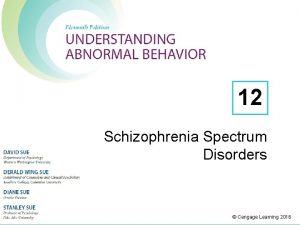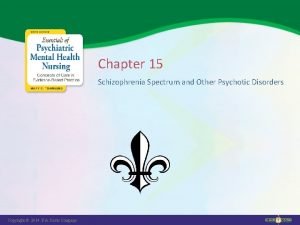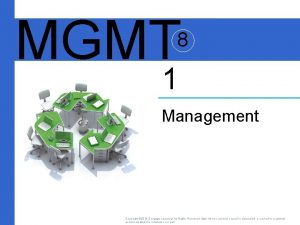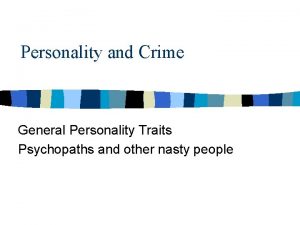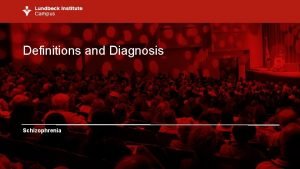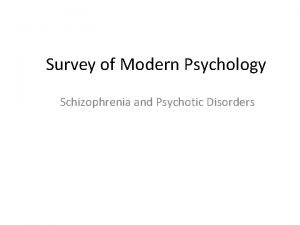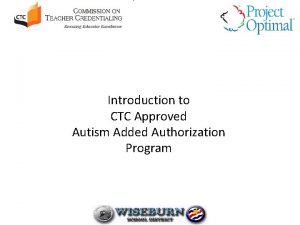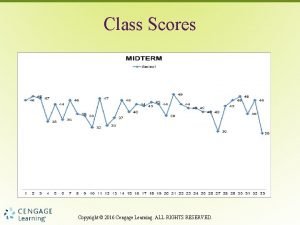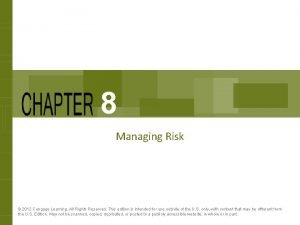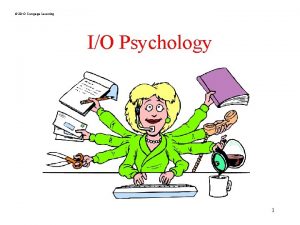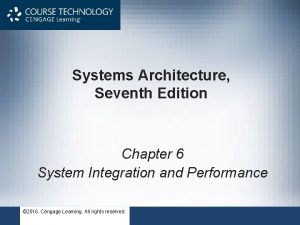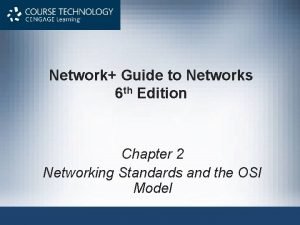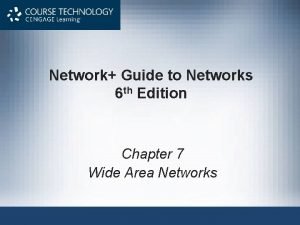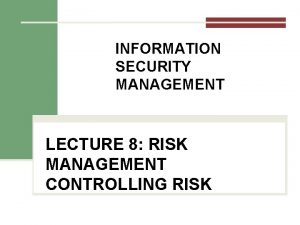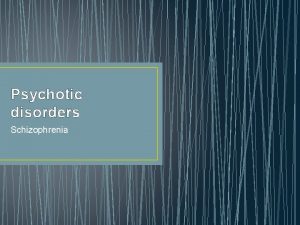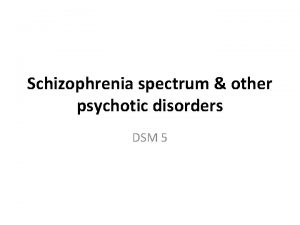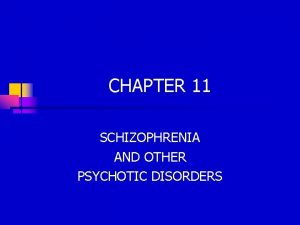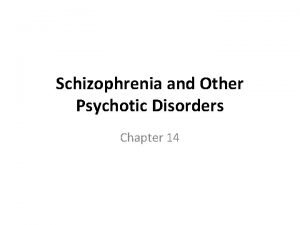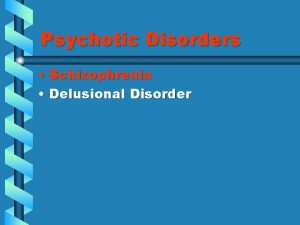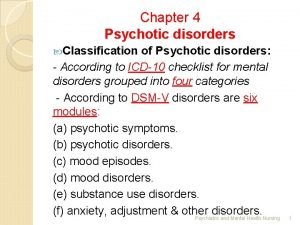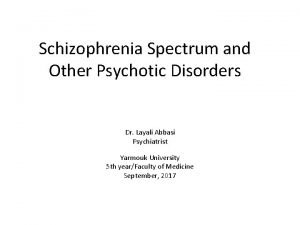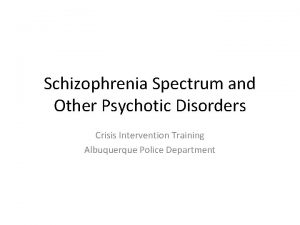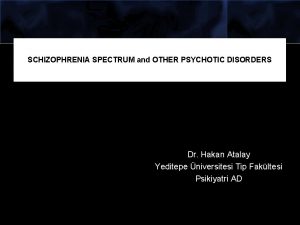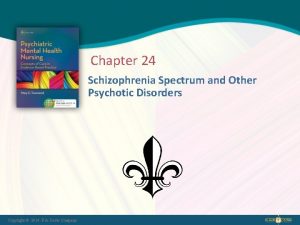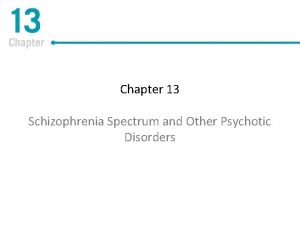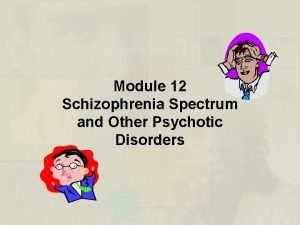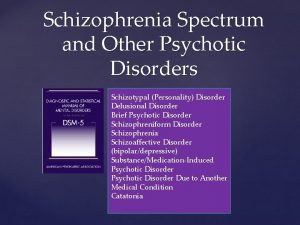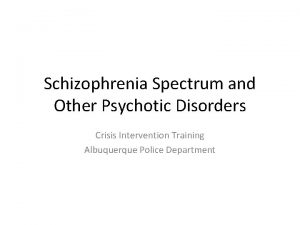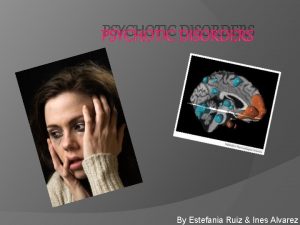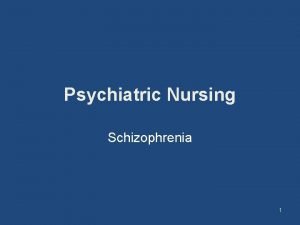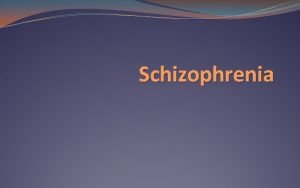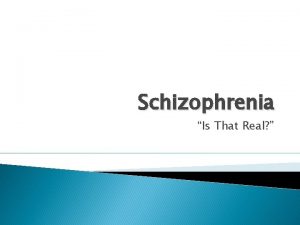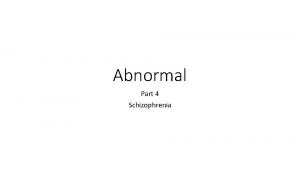Psychotic Disorders Schizophrenia Spectrum Disorders Cengage Learning 2016













































- Slides: 45

Psychotic Disorders Schizophrenia Spectrum Disorders © Cengage Learning 2016

Introduction Disorders on the schizophrenia spectrum Involve psychosis, impaired unusual social © Cengage Learning 2016 cognitive processes, or disorganized motor behavior, withdrawal

Symptoms of Schizophrenia Spectrum Disorders Symptoms fall into four categories Positive symptoms Negative symptoms Psychomotor abnormalities – catatonia, repetitive behaviors, agitation Cognitive © Cengage Learning 2016 symptoms

Positive Symptoms of Schizophrenia Delusions Hallucinations Disordered thinking Incoherent communication Bizarre behavior Symptoms range in severity, and may persist or fluctuate Poor insight Failure to recognize symptoms as abnormal © Cengage Learning 2016

Delusions False personal beliefs Consistently held despite evidence or logic Lack of insight common Delusional themes Grandeur, control, thought broadcasting, thought withdrawal, persecution, and reference Paranoid ideation Often connected with persecutory delusions © Cengage Learning 2016

Delusions Capgras Rare delusion Belief in the existence of “doubles” who replace significant others Acute Stressor: Developing suddenly after an emotionally distressing event Sudden © Cengage Learning 2016 Loss, Physical Trauma

Hallucinations Perception of a nonexistent or absent stimulus Auditory Most Visual (hearing) common type of hallucination (seeing) Olfactory Tactile (smelling) (feelings) Gustatory © Cengage Learning 2016 (tasting)

Cognitive Symptoms Disorganized thinking, communication, and speech Common characteristics of schizophrenia Ilogical, non-meaningful, disconnected Loosening of associations (cognitive slippage) Continual shifting from topic to topic without apparent logical or meaningful connection between thoughts © Cengage Learning 2016

Grossly Disorganized or Abnormal Psychomotor Behavior Catatonia Extremes in activity level Excited catatonia Withdrawn catatonia Peculiar body movements or postures Loud, inappropriate laughter; Incongruent Affect © Cengage Learning 2016

Negative Symptoms Decreased ability to initiate actions or speech, express emotions, or feel pleasure Avolition: inability to take action or become goal-oriented Alogia: lack of meaningful speech Asociality: minimal interest in social relationships Anhedonia: reduced ability to experience pleasure Misdx: Depression © Cengage Learning 2016

Negative Symptoms (cont’d. ) Diminished emotional expression Facial expression Voice intonation Gestures Approximately 15 -25 percent of individuals with schizophrenia display primarily negative symptoms © Cengage Learning 2016

Lack of Awareness of Psychotic Symptoms in Patients © Cengage Learning 2016

Understanding Schizophrenia Diagnosis involves presence of at least two of the following symptoms: Delusions Hallucination Disorganized speech Gross motor disturbance Negative symptoms Deterioration from a previous level of functioning © Cengage Learning 2016

Costs and Prevalence of Schizophrenia Financial costs of hospitalization, treatment, and loss of productivity Lifetime prevalence of schizophrenia in the United States Estimated $62. 7 billion annually 1. 1 percent Many show impairment in premorbid functioning Abnormalities prior to major symptom onset © Cengage Learning 2016

Phases of Schizophrenia Prodromal phase Social withdrawal and isolation Inappropriate affect Poor communication patterns Neglect of personal grooming Active phase Onset and buildup of symptoms Full-blown symptoms Residual phase Positive Sx subside; Neg Sx may persist © Cengage Learning 2016

Long-Term Outcome Studies Improving Treatments - living optimally with disorder Follow-up study results 10 year study Majority improved over time; minority deteriorated 15 year study 40% showed periods of substantial recovery Sizable minority were not on medication © Cengage Learning 2016

Factors Linked with Recovery Gender Women have a better outcome Higher education level Being married Having a higher premorbid level of functioning Intervention early in course of the illness Peer support and work opportunities also beneficial Depressive Sx © Cengage Learning 2016

Model of Schizophrenia © Cengage Learning 2016

Etiology of Schizophrenia: Biological Genetics and heredity play a role 50% Identical Twins Concordance rate Closer blood relatives have greater risk 16% chance for close relatives (e. g. mother and son) 4% chance for distant relatives (e. g. aunt and niece) 1% for general population © Cengage Learning 2016

Interactive Variables and the Onset of Clinical Psychosis © Cengage Learning 2016

Genetic Risk of Schizophrenia © Cengage Learning 2016

Neurostructures Decreased volume in the cortex and ventricle enlargements Rapid loss of brain cells over six-year period Ineffective communication between different brain regions May lead to the cognitive, negative, and positive symptoms © Cengage Learning 2016

Biochemical Influences Dopamine hypothesis Schizophrenia – caused by excess dopamine activity in certain brain areas Supported from research with three drugs Phenothiazines: block dopamine receptor sites L-dopa: increases dopamine levels and sometimes produces schizophrenic-like symptoms Amphetamines: increase dopamine availability; acute paranoid schizophrenia in non-schizophrenics © Cengage Learning 2016

Link Between Cannabis Use and Psychosis Cannabis use appears to increase the chance of developing a psychotic disorder Higher the intake, greater the likelihood of psychotic symptoms Several possible interpretations for link Cannabis may influence dopamine levels Individuals may use cannabis to self-medicate Individuals predisposed to psychosis may also be predisposed to use cannabis © Cengage Learning 2016

Correlates of Schizophrenia: Psychological Deficits in empathy Deficits in theory of mind Ability to recognize that others may have different emotions, beliefs, and desires Early developmental delay Low cognitive ability test scores in childhood and adolescence © Cengage Learning 2016

Correlates of Schizophrenia: Social factors contributing to risk Maltreatment during childhood Chronic bullying Relationships within the home Expressed emotion Negative communication pattern among relatives of individuals with schizophrenia © Cengage Learning 2016

Correlates of Schizophrenia: Sociocultural Ethnic differences Immigrant groups have highest rates of schizophrenia in Western Europe Especially those of African descent Other factors Lower educational level of parents Lower occupational status of fathers © Cengage Learning 2016

Cultural Issues with Schizophrenia Cultural Stigma - inapprop or abusive Tx Highly stigmatized in Japan Change in terminology in the year 2000 resulted in more patients being told of their disorder Many psychiatrists in Turkey will not mention diagnosis to clients or family Belief of supernatural causation in India © Cengage Learning 2016

Explanatory Models of Illness in Schizophrenia Among Ethnic Groups © Cengage Learning 2016

Treatment of Schizophrenia Standard treatment today Antipsychotic medication with some type of psychosocial therapy Recent shift from focus on illness and deficit to recovery, promotion of health, independence and self -determination © Cengage Learning 2016

Antipsychotic Medication Treats the Positive Sx, not neg sx Thorazine, Haldol Introduced in 1955 First-generation antipsychotics Still viewed as effective treatments Reduce dopamine levels Contemporary Tx: Risperdal, Zyprexa, Latuda, Abilify Atypical antipsychotics Act on both dopamine and serotonin © Cengage Learning 2016

Medication Side Effects: Extrapyramidal Symptoms Drop in Dopamine Levels Parkinsonism Dystonia Muscle tremors, shakiness, immobility Involuntary muscle contractions in limbs and tongue Akathesia Motor restlessness © Cengage Learning 2016

Other Side Effects of Antipsychotic Medication Neuroleptic malignant syndrome Muscle rigidity Tardive dyskinesia Involuntary and rhythmic tongue movement Chronic condition/ permanent damage Metabolic syndrome- cluster of conditions (hypertension, diabetes, high cholesterol) increase heart attack/stroke/coma © Cengage Learning 2016

Medication Effectiveness Older and newer medications have same effectiveness Newer medications much more costly Newer medication less side effects Between 50 and 75 percent of patients discontinue use of antipsychotics Complaints © Cengage Learning 2016 of side effects

Psychosocial Therapy Inpatient approaches Milieu therapy (hospital as community and patients have responsibilities) and behavioral therapy can be beneficial Psychosocial skills training: increasing appropriate self -care, conversational skills, and job skills Undesirable behaviors are decreased through reinforcement and modeling techniques Community homes can assist in transition from inpatient programs to community living; Independent Living Skill Building © Cengage Learning 2016

Cognitive-Behavioral Therapy Teach coping skills that allow clients to manage their positive and negative symptoms 18 -month follow up results: Those receiving CBT demonstrated more days of normal functioning compared to those treated with medication and contact with a psychiatric nurse © Cengage Learning 2016

Negative Expectancy Appraisals Associated with Negative Symptoms © Cengage Learning 2016

Cognitive-Behavioral Therapy Steps Engagement Assessment Identification of negative beliefs Collaborative analysis of symptoms Development of alternative explanations Recent approach Teach clients to accept hallucinations in a nonjudgmental manner © Cengage Learning 2016

Interventions Focusing on Family Communication and Education Normalize family experience Demonstrate concern, empathy, sympathy Educate family members about schizophrenia Reduce criticism/blame Identify strengths and competencies Develop problem solving and stress management skills Strengthen communication © Cengage Learning 2016

Other Schizophrenia Spectrum Disorders Delusional Brief disorder psychotic disorder Schizophreniform Schizoaffective © Cengage Learning 2016 disorder

Schizophrenia Spectrum and Other Psychotic Disorders © Cengage Learning 2016

Comparison of Some Schizophrenia Spectrum Disorders © Cengage Learning 2016

Contemporary Trends and Future Directions Early identification and treatment of high risk individuals Prophylactic treatment to prevent onset Antipsychotics Therapy - improve stress management; family functioning © Cengage Learning 2016

Life with Schizophrenia https: //www. cnn. com/videos/us/2014/06/09/ac-dntschizophrenia-simulator. cnn Living with Hallucinations Four Individuals with Sz https: //www. youtube. com/watch? v=b. Wa. Fqw 8 Xnp. A © Cengage Learning 2016

Review What are the symptoms of schizophrenia spectrum disorders? Is there much chance of recovery from schizophrenia? What causes schizophrenia? What treatments are currently available for schizophrenia, and are they effective? How do other psychotic disorders differ from schizophrenia? © Cengage Learning 2016
 Chapter 12 schizophrenia spectrum disorders
Chapter 12 schizophrenia spectrum disorders Is schizophrenia on a spectrum
Is schizophrenia on a spectrum Looseness of association example
Looseness of association example Mgmt+8
Mgmt+8 Psychopath personality
Psychopath personality Schizophreniform disorder icd-10
Schizophreniform disorder icd-10 Types of delusion
Types of delusion Difference between neurotic and psychotic
Difference between neurotic and psychotic Chromium and copper electronic configuration
Chromium and copper electronic configuration Absortpion
Absortpion Puberty and autism spectrum disorders
Puberty and autism spectrum disorders Autism spectrum disorders added authorization
Autism spectrum disorders added authorization 2009 delmar cengage learning
2009 delmar cengage learning Medical terminology chapter 5 learning exercises answers
Medical terminology chapter 5 learning exercises answers Cengage learning heart diagram
Cengage learning heart diagram South-western cengage learning
South-western cengage learning Chapter 13 medical math assignment sheet cengage learning
Chapter 13 medical math assignment sheet cengage learning 2009 delmar cengage learning
2009 delmar cengage learning Cengage learning heart diagram
Cengage learning heart diagram Chapter 1 matching medical terminology
Chapter 1 matching medical terminology Cengage learning australia
Cengage learning australia Graphing tpr
Graphing tpr Cengage learning
Cengage learning Cengage learning
Cengage learning Wadsworth cengage learning
Wadsworth cengage learning Cengage learning
Cengage learning Cengage learning plant cell
Cengage learning plant cell Cengage learning
Cengage learning Cengage learning
Cengage learning Brooks cole cengage learning
Brooks cole cengage learning Pharyngorrhea
Pharyngorrhea 2014 cengage learning accounting answers
2014 cengage learning accounting answers Copyright cengage learning. powered by cognero
Copyright cengage learning. powered by cognero Cengage learning
Cengage learning Cengage learning
Cengage learning Chapter 6 the skeletal system answer key
Chapter 6 the skeletal system answer key Cengage learning
Cengage learning Chapter 10 cultural diversity
Chapter 10 cultural diversity Consumer behavior cengage
Consumer behavior cengage 2012 cengage learning
2012 cengage learning Cengage learning 2013
Cengage learning 2013 Cengage learning psychology
Cengage learning psychology Course technology cengage learning
Course technology cengage learning Course technology cengage learning
Course technology cengage learning Course technology cengage learning
Course technology cengage learning Course technology cengage learning
Course technology cengage learning

